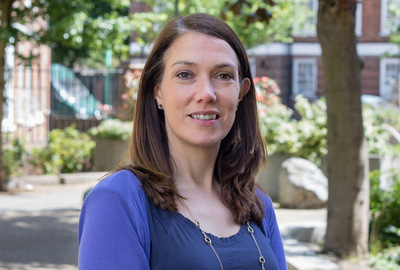- OT
- Professional support
- AOP
- “COVID-19 hasn’t changed domiciliary eye care, but it has changed our perspective of it”
Perspectives
“COVID-19 hasn’t changed domiciliary eye care, but it has changed our perspective of it”
Optometrist and AOP chairman, Dr Julie-Anne Little, discusses the evolution of domiciliary eye care and the changing face of patients accessing care at home

28 February 2022
The constraints that COVID-19 and repeated national lockdowns have placed on community eye care since March 2020 have really brought the benefits of domiciliary eye care to the fore. Looking at the domiciliary eye care model pre-pandemic, on reflection it was quite marginalised, with the fact that the majority of patients served by domiciliary optometrists were based in care homes and that treating people in their own homes had become rare. During the pandemic, we have come to remember that the domiciliary model needs to serve all of those members of our society who cannot easily access eye care services outside of their own home, regardless of where their home may be. This evolution has been a long time coming. In a way COVID-19 hasn’t changed domiciliary eye care, but it has changed our perspective of it. I think domiciliary eye care will continue to evolve and grow as a model in the future.

As an educator, I work at Ulster University. Last year, the OutsideClinic delivered an excellent webinar programme to our students that aimed to expose them to the concept of domiciliary eye care, raise awareness of this sector and reach out to the next generation of optometrists. Rather than give a lecture, students got to watch an observation of a domiciliary eye exam, which was followed by a question-and-answer session. It was really well received. If you have never experienced something, it can very easily feel like it is a niche thing that you couldn’t possibly do, but the students now have real-world insight into this rewarding aspect of optometry.
Domiciliary optometry can be a quite an attractive career path for many professionals due to the flexibility that it can offer. We are living in an era of flexible working, and as optometrists seek variety to their working week, on a part-time or full-time basis, this mode of practice fits well with this.
During the pandemic, we have come to realise that the domiciliary model needs to serve all of those members of our society who cannot easily access eye care services outside of their own home, regardless of where their own home may be
When I was a child, I remember my grandmother having a domiciliary eye exam and the optometrist lugged in a big test chart to hang on the wall. It did not look like a whole lot of calibration was done, which is so simple nowadays with the array of digital solutions that are available. Domiciliary optometry and the technology used by optometrists in this sector has advanced a lot in the last decade or so. Gone are the days when it could be considered a sub-standard test. It is most definitely not nowadays.
Technology is so much more portable than it used to be, which has been embraced by domiciliary optometry. In fact, the domiciliary eye care sector could be considered well ahead of the High Street curve in terms of some technology advancements. It was the first to have electronic case records and those types of systems, and it embraced the benefits that could be brought through portable electronic devices. You can open a laptop and run software to get an appropriate visual acuity test in a matter of seconds. There are also portable slit lamps and cameras available today that offer great quality imaging.
The spectrum of patients accessing domiciliary eye care is much broader today than it was pre-pandemic. Younger patients are now accessing eye care at home due to a wide range of reasons such as anxiety, mental health and mobility. These are patients who may have struggled to but were attending practice previously, but it is also those who were not having their eye care needs met at all before the pandemic. Being able to increasingly showcase domiciliary eye care as an option for people who cannot access the High Street, those who are shielding or cannot easily go out into their community, is more important than ever before. It used to be that domiciliary equalled old, but that is no longer the case.
Domiciliary optometry and the technology used by optometrists in this sector has advanced a lot in the last decade or so. Gone are the days when it could be considered a sub-standard test. It is most definitely not nowadays
As we become a larger, ageing population with people living longer, our needs, including our eye care needs, change. In the future, the delivery of enhanced services such as MECS needs to be easily provided by those working in domiciliary eye care services. The challenge for this service delivery currently is the contractual obligations that mean optometrists must notify the NHS 48 hours before they enter a person’s home. This, in my view, is the single biggest day-to-day challenge for domiciliary optometrists currently. They cannot be flexible in their appointments or respond the same day to see a patient who may require eye care that is non-routine. This poses a real gap in the delivery of care. It is the opposite of equality – by virtue of you being in a home, you cannot access these services in the same way as others.
Domiciliary optometrists are one of the few groups of people that get to interact with patients in their own environment. Entering someone’s home, they get a unique window into that person’s general care and wellbeing. Therefore, it would absolutely make sense if they were more joined up to social and support services so that they could better signpost patients to services that they may not have already engaged with. This unique view also has benefits for the eye care being provided as the optometrist can observe the challenges that the patient may face that they would have never thought to brought up in practice.
Unfortunately, the term domiciliary is not that meaningful to a patient. It’s an old-fashioned type of term. I feel that we should look to make the name of the offering more meaningful to members of the public so that they can better understand what they are entitled to.
About the author
Dr Julie-Anne Little is an optometrist, chairman of the AOP Board and a senior lecturer in optometry and vision science at Ulster University
Advertisement


Comments (0)
You must be logged in to join the discussion. Log in